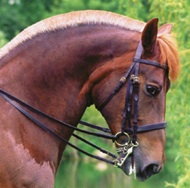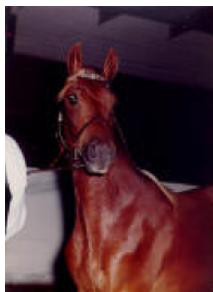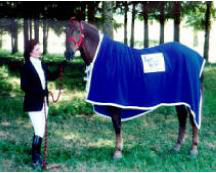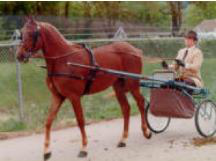How My Horse 'Bronze' Invented The Ansur Saddle
VP Of Research And Development for Ansur® Saddlery Northwest, LLC

Bronze is a large purebred Morgan horse, who at the age of 13, helped us understand what a horse wants in a saddle. How did this come about?
The story is below. Included are excerpts from *“Mountain View Bronze, A Million Dollar Morgan” (written by Rebecca Holmes and originally published in the Morgan Horse Journal. March, 2001.)
What value do we place on something of intrinsic worth? Is it a million dollars? Two million? For many of us, horses are worth much more that the purchase price. They make us laugh, cry and, sometimes, give us the will to survive.

Mountain View Bronze is a Morgan. He’s a dressage horse trained to Prix St. George. He invented a new saddle. His owner, Carole Weidner, certainly would never sell him – not even for a million bucks.
Thirty years ago, Carole decided to buy a dressage prospect. Her selection process was simple and, as she says, “to be honest, quite stupid..” Her first requirement was a quiet willing temperament. Her second (and only other) was size, because she knew “dressage horses” were supposed to be big.
Thus armed, Carole visited Mountain View Morgans in Ridgefield, Washington to look over their foal crop. One two-week colt stood out from the others. His name was Mountain View Bronze (Reed’s Gallant Duke x Shawalla Bon Bon) and his feet were huge. Big feet on a colt must mean a big adult, Carole thought, so she bought him.
Bronze lived up to his coltish feet; he matured to 16.2 hands. As a youngster, he was shown at halter and taught to drive. At age four, he was ridden every weekend in the nearby Cascade Mountains. Carole says, “I could have done nothing better for him. Trail riding was a real challenge as he was the clumsiest thing on four legs you’ve ever seen. He had grown so fast that he simply could not handle himself.” Carole describes a trip where he rubbed off his halter and ran “hither, thither and yon” terrorizing all the other horses and their owners. When he tried to put on the brakes, they failed. He fell and slid to the spot where he had been tied, just as if sliding into home base.
His youthful antics around the home farm are legendary. Once, Bronze escaped from his pasture. Bucking along the neighbor’s fence, he took exact aim and kicked every middle board in half. Carole’s husband, Don, was nearly hysterical and his comments filled the air, “that horse is out of here….enough is enough….” Carole shook a can of grain and called. Bronze came, stood to be haltered, and walked home like a gentleman. Meanwhile Don went to town to buy 14 ten-foot boards. As you might expect, things were a bit quiet around the house that evening.
During those early “Bronzie” years, the neighbors were always watching him and taking pictures. Carole says, “They had never seen such a wild man and simply could not believe I actually rode him.”
On Christmas Eve in 1992, Carole learned from her doctor that she had breast cancer. Twelve days later, she underwent a double mastectomy.
Two weeks after her surgery, against doctor’s orders, Carole rode Bronze. Friends saddled him and with the help of a ladder, Carole climbed aboard. She managed a walk, a trot, and finally a canter. As she rode, the anger and shock lessened, as did questions of whether she would be able to ride or how long she had to live. “It was a bright day for me”, Carole says, “A beautiful feeling.”
Carole scheduled cancer treatments around her riding. It took a full day to recover from chemotherapy and on the next, she’d ride Bronze. Treatments were not easy and many times she’d wonder how she’d get through another day. “Well, I’ll just ride”, was her usual answer.

During that difficult year, the pair had a banner show season, winning awards from both the United States Dressage Federation and the American Morgan Horse Association. Carole placed third in the nation for USDF riders over the age of 50 and first among all USDF riders on Morgans. Bronze took high pointing open AMHA competition. Carole states, “Physical healing can take place when there are other things to think of. Everyone going through this should have a Bronze”.
After the banner year in 1992, Bronze went into intensive training in preparation for FEI dressage competition. But something began to change. The horse with the intense concentration and work ethic of a champion began showing resistance to advanced work. In some cases, he actually regressed. He started being a little sticky on his right lead. He became braced in his back, sucked back into his wither, wrung his tail and slowly began to change from “opinionated” to slightly argumentative when asked to execute movements that he had already mastered. Was Carole’s champion and soul-mate announcing his retirement?
Having had such an intimate connection with her horse and knowing his willingness to try anything he was asked, Carole could not believe this was possible. She had provided the horse with a number of custom fit saddles, different bits and all the usual types of "fixes," none of which worked. She decided to have a thorough examination of the horse by his long time veterinarian. All the customary tests, radiographs and examinations were performed; the conclusion was that Bronze’s health and physical condition was excellent. Further studies were done by chiropractors, equine therapists of various specialties and another comprehensive study by a group of medical professionals at a university. None of the tests produced any evidence of unsoundness. No problems could be detected when the horse was not being ridden. The problems showed only when Bronze was asked to carry the load of his rider.
Was Carole as his long-time rider and loving owner at fault? She carefully watched the horse when being ridden by her coaches. No, changing riders did not make a difference. Bronze still continued to resist. His stride was shorter, he hollowed his back…it became a challenge to see how quickly the rider could bring his back up again as he dropped out from underneath the saddle. He even began to pin his ears and swish his tail. These signs had not been apparent until Bronze began his upper level work.
Well now……what else could the problem be? Had Bronze gone “ring sour”? Was he suffering “burn out”? Was his training program not right? Was he objecting to his saddle…again?

Considering that Bronze demonstrated unhappiness and bracing when being ridden, Carole and her coach, in pure desperation, took the current “custom fit” saddle off his back and rather than to try yet another one, this time they put a simple bareback pad on him.
VOILA!! Immediately, Bronze danced. He offered all the correct movements he had been taught and even offered moves Carole didn’t know he understood or possessed. Finally, Bronze had made his point. He “told” Carole that he would have no more constricting, painful saddle trees on his back. He “said” he would willingly perform as requested, but only in the soft bareback pad.
Now, what to do? Competitions, in which the pair had been heavily involved, were out of the question. Competitions require a saddle. Bronze would not be allowed in the show ring using a bareback pad. Carole continued to school Bronze on a daily basis using the pad, but without having the ability to show their progress to an independent judge, a big part of the fun they had enjoyed together had disappeared. So, the mission was now totally clear: somehow a competition saddle had to be developed that Bronze would accept.
To develop a show-legal, soft saddle that would in no way constrict Bronze’s movements? How did one do this?

A visit to a local saddler, laying out the entire problem resulted in his agreement to help develop and construct an English style, totally soft saddle. Even though he had never made an English saddle let alone one without a rigid frame, he agreed to work with Bronze and his handlers to develop one.
They began with heavy leather saddle body pieces placed on Bronze’s back and progressed from there to an assortment of layers of trauma absorption materials. Each layer was tested on Bronze with a rider on top. If he short-strided or otherwise showed signs of any discomfort, the previous layer of the “saddle” was removed. After much trial and error, Bronze finally decided he had the “saddle” that he had been asking for…one which allowed him to move as he did in his bareback pad.
The next step was to make this new-fangled saddle comfortable for Carole. She felt that as long as it was going to be made right for Bronze, a layering system should be put in place to make it just as comfortable for her.
When Bronze and Carole went back into their first competition using Bronze’s new soft saddle, a good deal of interest and discussion took place among the other competitors. Why had Bronze taken such a huge leap in his performance? What had changed? He had never moved like this. What have they done to this horse?
When the news leaked out that they had built a new saddle especially for Bronze, other riders really began asking questions. As a result of this interest, the saddle was tested on many other horses. What a surprise that was! Nearly all of the horses responded better when ridden in the Ansur® saddle. It soon became clear that this saddle was no quirky indulgence (on Carole’s part) for an even quirkier horse (Bronze.) The test horses, almost without exception responded to the new saddle with improved performance and willingness to work.

About this time, Carole’s phone began to ring. Riders were calling, asking where they could purchase one of these saddles. Owners of the test horses wanted a saddle; riders that had seen the show were interested in purchasing one. As a result of the calls, a small start-up company was formed. The local saddle maker who was involved in all the prototypes was contracted to manufacture a few saddles for the riders who were calling.
Over the next few months, the local saddler, whose area of interest remained with his western saddle business, sold the equipment and expertise he used when making the soft saddles to the fledgling company. This was the official beginning of what is now known as Ansur® Saddlery Northwest, LLC.
*Bronze has come a long way from that big colt who usually ended up in a heap when he got rambunctious. To Carole, he is a treasure and a true ambassador of the Morgan breed. His willingness to do whatever is asked of him, forgive his rider’s mistakes and allow the rider to “try, try and try again” is irreplaceable.
He gave his rider the will to conquer a serious illness and earned her great love. Mountain View Bronze is truly a Million-Dollar Morgan, not in cold hard cash, but in intrinsic worth. And there are no price tags on things of intrinsic worth, for the simple reason they are not for sale.
Bronze’s question, “How can you ask me to willingly bend and move properly when you’re sitting on top of a lump of wood and pressing it into my back?” had finally been understood and answered. Carole’s soul-mate was rewarded for his innovative development of the saddle with a lifetime title which will forever belong only to him: Vice President of Research and Development.
MOUNTAIN VIEW BRONZE, resting in peace. April 2, 1982 - August 10, 2005
